This is a relay of my workflow and creative process when completing my assignments for "Introduction to Digital Music Techniques" as a second year student at the University of Sydney Conservatorium of Music.
Don't wanna be here? Send us removal request.
Text
Introduction to Digital Music Techniques: Final Assessment
For the final assessment, I chose ‘option 3,’ that is, to extend my “cataplexy” inspired piece from the first assessment. I chose this because for the first assessment I was unable to sing (due to Laryngitis) and it forced me to explore a genre/style and techniques that I have never considered before whilst writing or recording my music. I found it really enjoyable to create something so different but still somewhat pleasant to take in (from my point of view). After making this decision I began binge listening to so many different sub-genres of EDM, ranging from deep house to Psychedelic trance. I listened to several tracks by Armin Van Burren, Bryan Kearney, Gorgon City, Above and Beyond and many more (EDM mixes). I did this not only to get some structural insight and understanding of contrast with smooth transitions but to listen out for techniques and effects that are prominent in EDM. Like the previous two assessments, I completed this piece using Logic Pro X in the Studios (1025) at the Sydney Conservatorium of Music.
INTENTION:
With my original piece I completed for the first assessment, I wanted the track to lean more toward the sub genre of ‘deep house’. But this time around I really didn’t want to be limited, as I was inspired by the wide range of EDM I had been consuming. But before even considering the ideas I had for the two new sections, the first thing I wanted to do was to rectify that which was suggested in the feedback for the first assessment.
SECTION B REVAMP:
I began with section b, adding a few cross-rhythms and slightly spicing up the MIDI drum track with a pitched rhythmic movement (MIDI sound called animated swirls which I looped playing two chords) to accompany it. This allowed me to create more interest whist still staying true to my ‘breakdown/simple drum’ vision for section b from the first time. I also added panning in the ‘breakdown,’ where the only thing that is present is the chords and hi-hat (build up). I then added a melody, hitting record once I completely improvised and just ran with it! I didn’t hesitate to quantise this though, I used several plugins and effects (shown below).I also added a dirty toned yet simple bass line which sort of stays true to the ‘deep house vibe’ whist the melody and chords are more true of house. Overall this section sounds so much more complete then my first attempt, the feedback was really helpful.
MIDI drum track:
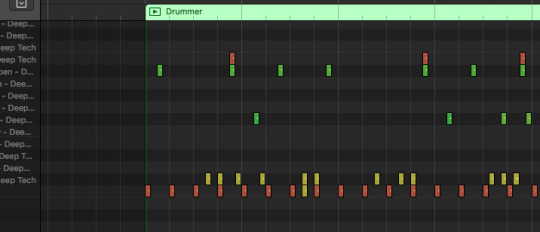
Melody:
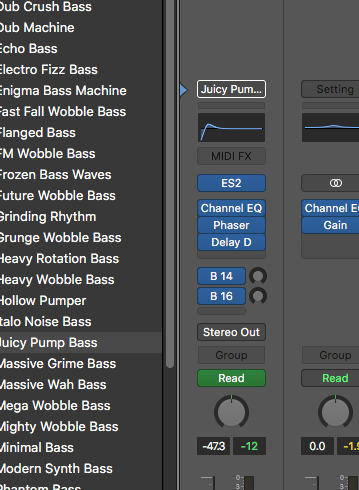
Hi-hat panning:
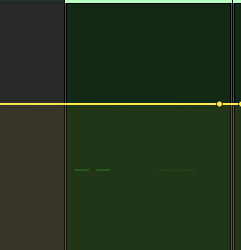
Section A Revamp:
Oddly enough, I made slight alterations to this section after section b. Not too much was changed here besides the addition of a quick vocal phrase and a rhythmic MIDI melody added over the chords (with panning). I recorded myself singing the word “crossover” and then added a tape delay, increasing the feedback rate (progressively) to give a sort of ‘dreamy’ but ‘dark’ ambience. This is to reflect the ‘dreamy’ MIDI effect which the track begins with, followed by the dark simple bass line. After discovering the ‘touch’ feature in automation on logic, I was able to speed up the delay/feedback in real time to create a build in pitch/temp for anticipation.
vocal delay and automation:
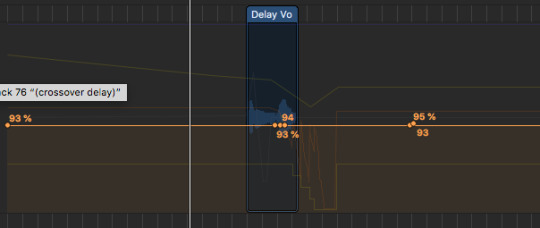

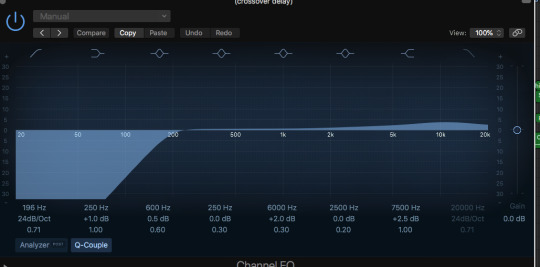
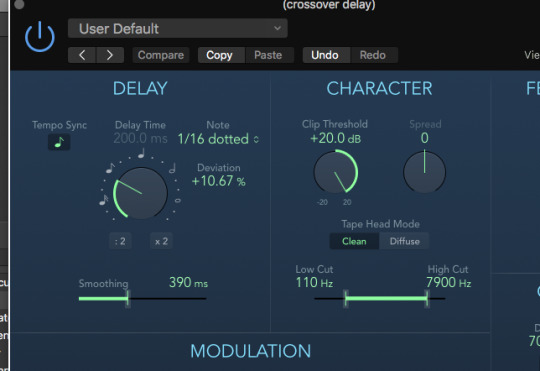
VISION:
In terms of artistic vision, I really wanted this track to catalyse colourful imagery with the listener’s mind. Almost like a VR experience, from a dreamy colourful landscape to a dark alley and even some what of a rave in the last section. I guess the inspiration came from the feeling I experienced whilst listening to different types of EDM, so I wanted that to be the focus of this track. Section b almost reminds me of video game music, and that was intentional as I wanted this to be the sound track to an alternate place/experience, consistently travelling in somewhat of a trance. This also correlates with the ‘crossover’ theme.
NEW SECTIONS:
Section A returns
This time section A returns but rather than a synthesised rhythmic melody, a vocal melody takes hold. Before the ‘verse’ begins, I recorded myself taking a breath out and put a heavy tape delay over it, once again altering the delay in real time to create a build up. I again improvised the lyrics for this section, really wanting it to sound fun and catchy but still have relevance to both the title and previous sections. I double tracked my voice for the first half of the verse as I felt it gave more of a full effect to the section after the build up. I also did subtle harmonies over some words using the telephone vocal filter. I used various plugins under Izotope in Logic such as de-clip, de-click and de-ess to reduce noise as well as EQ and adequate trimming. I also used ‘Chroma’ reverb ever so slightly just to make the vocals sound a bit more warm.
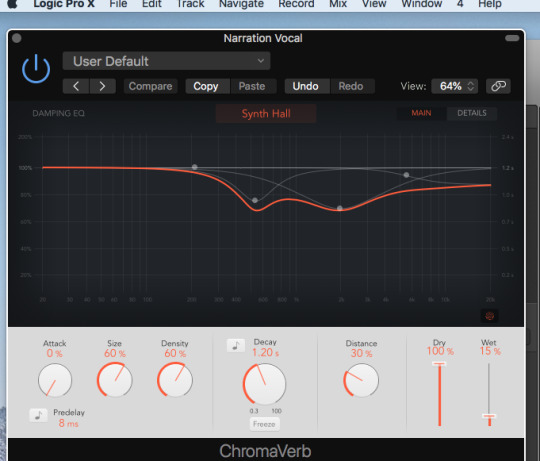
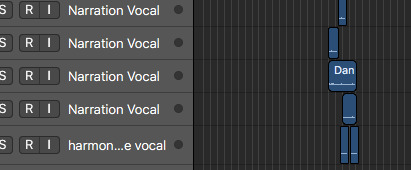
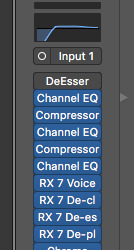
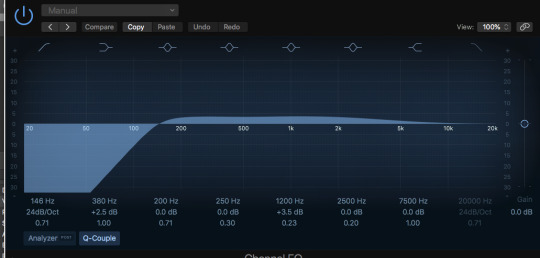
Section C:
Unlike the previous sections, section c begins with a complete drop out of all drum tracks, only vocals and chords. The inspiration for this section came from the vocal phrase that I manipulated, I build the whole section around this phrase. This sort of happened by accident….I was trying to figure out how to automate reverb and came across the ‘real time’ feature under ‘read’ called ‘touch’ in automation which allows you to play with the EQ of a track in real time. This obviously led to the discovery of automating individual plugins rather than just the entire track which is selected. I realised I found something quite interesting and instantly got a ton of ideas, noticing the resemblance in the EDM I had been listening to. But this wasn’t so easy to achieve, it took a plethora of trial and error and some youtube Logic tutorials to get this done. In fact I nearly scraped it at one point out of frustration (and pain due to back issues) but felt persistent to finish what I had started. I trimmed one tiny vocal phrase from some improvised lyrics I recorded and copied and pasted them in line with the bar lines. I couldn’t loop the track as for some reason when I did it was out of time. I then began with the EQ on the far left (screenshots below) and slowly dragged the EQ, going from a muted to a clear sound. This seems to be ever so present in EDM music as it aids the build up. I then added a tape delay and reverb then individually automated these effects, altering feedback rate and delay time. Working on this took up more time than anything else for my piece ! But I think it sounds really cool and I’m glad I pushed through it and produced something different.This section also includes a simple kick that I recorded on the midi and looped but adjusted the EQ to make it sound sort of ‘muted’ and deep house like.
Chords:
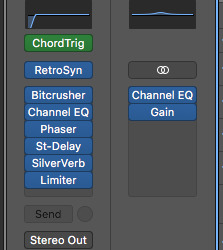
VOCAL EDIT:
EQ gradual movement.

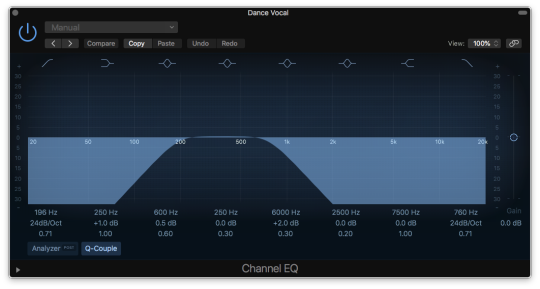
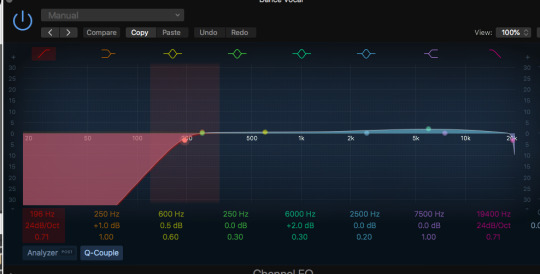


SECTION D: variation of section A
For this section, the chords in section A return but are varied, played both descending and ascending. The filter (MIDI sound) that is used for the section b melody returns but with just a long sustained chord for the entire section. But before this the ‘heavenly sound�� returns from the songs intro, contributing to the dreamy ambience. This MIDI chord paired with the muted kick give a sort of ‘club’ or ‘dark’ feel. I also included what I like to call a ‘trance cry,’ I recorded myself singing “ahhh” with some heavy delays again. Paired with the bass line it sounds both dark and dreamy (the vibe). It took time to get the delay/feedback in TIME with the rest of the piece ! I like that the kick remains for this section contributing to the trance-rave-dreamy sort of vibe. At the very end I recorded myself singing crossover a few times over ‘telephone vocal filter’ and in real time played with the EQ to make it sound muted at first then kind of robot like. I felt the end of the track needed this as it sort of addressed/revisits what happened in section one. (below)
vocal delay:

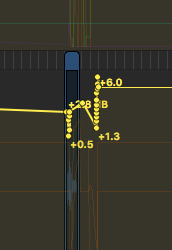
Telephone ending:

Throughout the ENTIRE track automation was CRUCIal so it was used a lot:
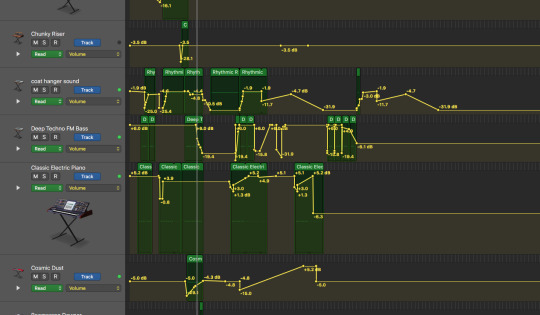
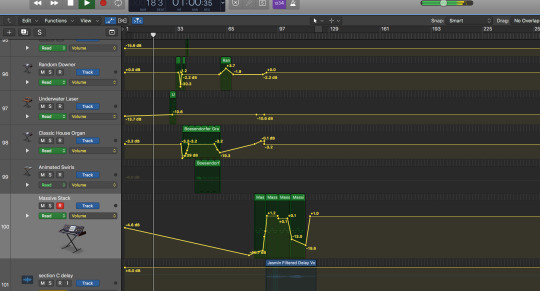
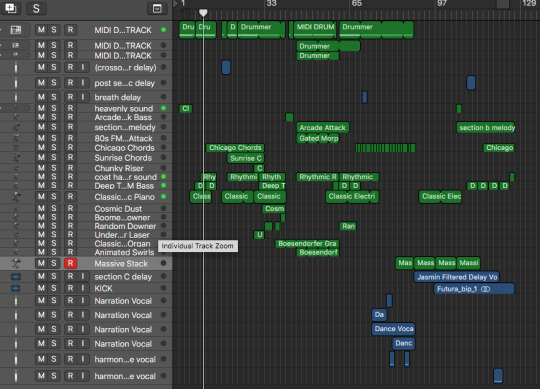
Overall I am satisfied with the completed track. I am really keen to understand and learn more techniques and skills in different DAWS as well.
https://soundcloud.com/jasmin-mourad-698719626
0 notes
Text
Recording Assignment - Introduction to digital music
Group Members: Jasmin Mourad, Lucy Laidlaw & Athanasia Sakoutis.
Artist: Helen Xu
Helen is a second year Psychology student at the University of Sydney but has been playing piano for just over 15 years and absolutely loves music. When our group approached her, she was so keen to help us out. She selected the song; “When the Party’s Over” by Billie Eilish and we were all thrilled as we absolutely love this piece.
Recording Process:
We borrowed a Zoom Recorder from the Sci-tech library (as suggested in the UOS outline) and agreed to record the piece in the Seymour centre (Room 412) as there is access to a grand piano/quietness. We captured various ‘test recordings’ and played them back through headphones and laptop speakers, attempting to find the optimal distance between the sound source and the mics on the zoom. We did some research online and it was suggested to record the piano by placing the zoom inside of it. We tried this but during playback there was noticeable distortion/clipping. So Lucy, ever so steadily held the zoom completely still during the recordings, hovering it approximately 20cm above the inside of the piano. We found this worked best, capturing a clear sound without distortion. We record 4 whole takes of the song (refer to recording track sheet) and 2 additional takes starting from the bridge.

Editing Process:
I didn’t end up using the short takes we recorded that started from the bridge but instead just used the four full takes. To edit these four recordings, I used Logic Pro X in the studios at the Sydney Conservatorium of Music. I imported each stereo track into an empty project then one by one listened to them, with both headphones and through speakers. I selected the best parts of each track, that is the parts that were played the best (no mistakes), minimal background noise and minimal clips/distortion from the mic placement. I then trimmed these parts and linked the bars up so that each section was in succession as seen below.

As seen above, each track is labelled using the same name as the raw audios files that were handed in during class (for comparison/reference). It took a while re-arranging the tracks as I changed my mind quite a bit. When I listened with headphones, my ear picked up things that I didn’t notice whilst listening through speakers and vice versa. But I settled with the placement of tracks above. Due to the trimming, the transitions between each track sounded unnatural and there were also clicks/pops. To rectify this, I used the mixer/grid editor (zoomed in a lot) to do some micro trimming. I also used automation to make the transitions smoother. I also automated throughout each track as there were pops/clicks from the pedal as Helen was playing and background noise present during rests in the piece.





Overall I am satisfied with the edited track, Helen played the piece beautifully and I tried my best to make the track sound smooth and free flowing. I also did all that I could to minimise/edit out pops, clicks, clips, mistakes and distortion without using filters or plugins. I just trimmed and automated. :)
0 notes
Text
Creating “Crossover”
Artistic Vision:
Originally I intended to create a piece using the structure of ‘Cataplexy’ in the genre of pop/acoustic r&b. The intro, verse 1, chorus, verse 2 and 2nd chorus would serve as ‘section A’ and the bridge would represent ‘section B’. Then a couple weeks into the semester I was diagnosed with Laryngitis AKA a vocalist’s worst nightmare. I was told I couldn’t sing for 4 weeks (until the 10th of May) and for a singer/songwriter who mainly has experience in writing lyrics, melodies and producing vocals, this was quite disheartening.
I found myself feeling a bit lost because I had never attempted to make music without first writing vocal melodies and lyrics as a sort of foundation for the song to be built around. But I quickly found myself feeling inspired by some instrumental deep house music my neighbour was blasting on a Friday night. I immediately noticed that there was no vocals….in fact, the structure seemed more simplistic then other genres of EDM I had previously heard. Although ‘Cataplexy’ may give off a more ‘trance’ vibe, something about its ’chill’ nature reminds me of deep house music. I love the consistent syncopated ‘hi-hat groove’ paired with synthesised EDM bass hooks; a seemingly reoccurring characteristic of deep house. As the repetitive riffs and catchy rhythmic ideas blasted through my neighbour's speakers; this immediately became my artistic goal. I wanted to create something that has repetitive, simplistic melodic, harmonic and rhythmic ‘hooks’ that makes you want to bop along. The name of the piece: “Crossover,” was inspired by the transitions occurring from one contrasting section to the next.
Work Flow:
I completed the piece using Logic Pro X in the studios at the Conservatorium. It took about 3 studios sessions (about 5 hours each) to complete my piece. I began with the drum beat, originally just using a loop until I worked out what I was after. I then ended up putting the loop through the MIDI so I could edit it and create my own unique drum track. The drums are completely contrasting in section A and B (section B is done without a drum loop foundation). I played with the EQ and slightly adjusted the reverb and Stereo delay until I was satisfied.
SECtiON A (editing/filters):

- adjusted EQ for the second track; - ‘heavenly sound’ in the intro, to produce a more ‘clean/high pitched’ sound.

The next sound that enters is the “rhythmic resonator” and it’s maintained throughout almost the entire piece; jumping from ‘middle ground’ to ‘back ground’. I have adjusted the EQ to try and diminish the high ‘crunchy/harsh’ sound that formed with the stereo delay/reverb.
- slight panning

The bass-piano ‘riff’ has been further EQ’d to diminish the lower frequencies and remove any rumble or white noise using a Low pass filter.

But a percussive ‘popping’ sound enters before this and sustains throughout most of the piece. I’ve adjusted the EQ and played with the stereo delay ‘rate’.

The ‘Chicago Chords’ melody has been EQ’d to sound a bit more ‘distant’ and less crisp along with the reverb (Silver verb) being adjusted.
SECTION B (editing/filtres):

The ‘build up’ sound leading to the transition has been EQ’d to block the high ‘squeaky’ sounds and also to produce a fuller sound.
Stereo delay has been adjusted
Compresser

- High pass EQ for transition synth (block chord sustained).

Weird flex/boing synth sound (transition to B section).
High pass and low pass.

- Same weird synth sound as above.
Added filters (peddle board.
Spin box.
Delay.
AUTOMATION:

Automation was super important whilst editing. Its was useful to ensure smooth transitions between sections.
Fade in
Fad out
Introducing new sounds
Overlapping sounds
EDITING:
Every track in the piece was EQ’d. - Automation
Trimming, copy/paste. - Compression
Quantisation. - Stereo Deals
Reverb - Ping pong Delay
Peddle board filters
Overall I am satisfied with my piece. It was really disappointing to have had my instrument (voice) be sort of taken away from me but it taught me how to create something without using my voice. Navigating the studios was a bit difficult due to my vision impairment but despite these obstacles I enjoyed myself.
Link: https://soundcloud.com/jasmin-mourad-698719626
1 note
·
View note